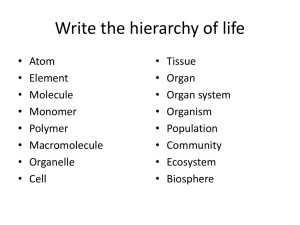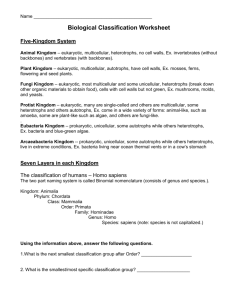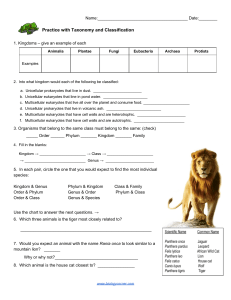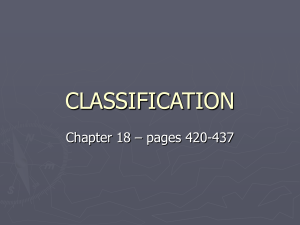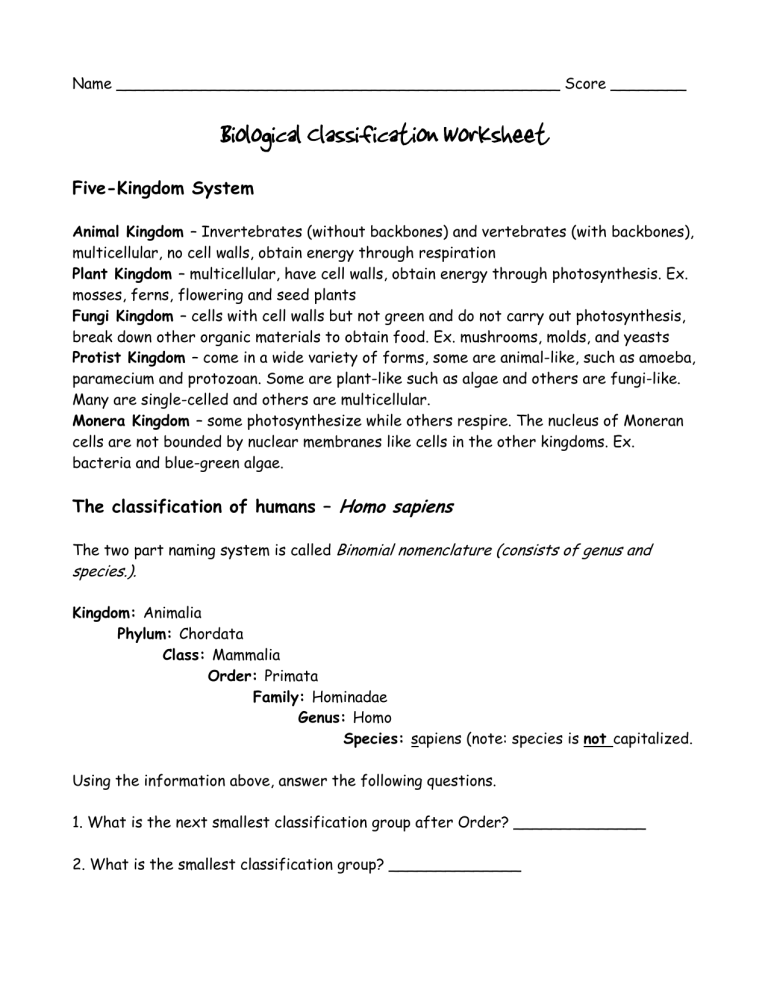
Name _______________________________________________ Score ________ Biological Classification Worksheet Five-Kingdom System Animal Kingdom – Invertebrates (without backbones) and vertebrates (with backbones), multicellular, no cell walls, obtain energy through respiration Plant Kingdom – multicellular, have cell walls, obtain energy through photosynthesis. Ex. mosses, ferns, flowering and seed plants Fungi Kingdom – cells with cell walls but not green and do not carry out photosynthesis, break down other organic materials to obtain food. Ex. mushrooms, molds, and yeasts Protist Kingdom – come in a wide variety of forms, some are animal-like, such as amoeba, paramecium and protozoan. Some are plant-like such as algae and others are fungi-like. Many are single-celled and others are multicellular. Monera Kingdom – some photosynthesize while others respire. The nucleus of Moneran cells are not bounded by nuclear membranes like cells in the other kingdoms. Ex. bacteria and blue-green algae. The classification of humans – Homo sapiens The two part naming system is called Binomial nomenclature (consists of genus and species.). Kingdom: Animalia Phylum: Chordata Class: Mammalia Order: Primata Family: Hominadae Genus: Homo Species: sapiens (note: species is not capitalized. Using the information above, answer the following questions. 1. What is the next smallest classification group after Order? ______________ 2. What is the smallest classification group? ______________ 3. Every living organism has what classification groups as its name? _________ and ________ 4. The first letter of every genus name is ______________. 5. The first letter of every species name is _______________. 6. What is binomial nomenclature? _______________________________________. 7. Give one example of how you classification is used at school. 8. Why is the understanding of classification an important life skill? Name _______________________________________________ Score ________ Classification Practice – Animals Part A In the exercises that follow, arrange the items listed into different groups. Give each group a title indicating what the members of that group have in common. 1. German Shepherd, Great Dane, parrot, Irish setter, canary, husky, robin, pigeon Title _____________________ _____________________ _____________________ _____________________ _____________________ Title ______________________ ______________________ ______________________ ______________________ ______________________ 2. Apples, peas, orange, banana, carrot, lettuce, turnip, pear, grape, potato Title _____________________ _____________________ _____________________ _____________________ _____________________ _____________________ Title ______________________ ______________________ ______________________ ______________________ ______________________ ______________________ 3. Steak, football, sausage, chair, table, bacon, sofa, baseball bat, cleats, ham, bookcase Title _________________ Title__________________ Title_________________ _________________ __________________ ________________ _________________ __________________ ________________ _________________ __________________ ________________ _________________ __________________ ________________ _________________ __________________ ________________ Part B Study the following list of living things: Mare, trout, parrot, quarterhorse, woodpecker, spaniel, goldfish, Great Dane, eagle, bass, beagle, hawk, stallion, Dalmatian, shark 1. Classify them into two groups (give each group a name). Group 1 ____________________ Group 2 ___________________ 2. Using the same list of living things show how they could be classified into three groups. Group 1 _____________ Group 2 ______________ Group 3 _____________ 3. Using the same list, show how they could be classified into four groups. Group Group Group Group 1 ______________ 2 ______________ 3 ______________ 4 ______________ The most exciting phrase to hear in science, the one that heralds new discoveries, is not Eureka! (I found it!) but rather, "hmm.... that's funny...." -Isaac Asimov Touch a scientist and you touch a child. -Ray Bradbury

